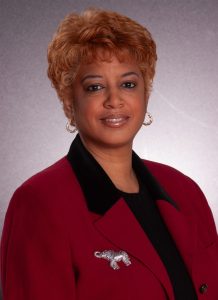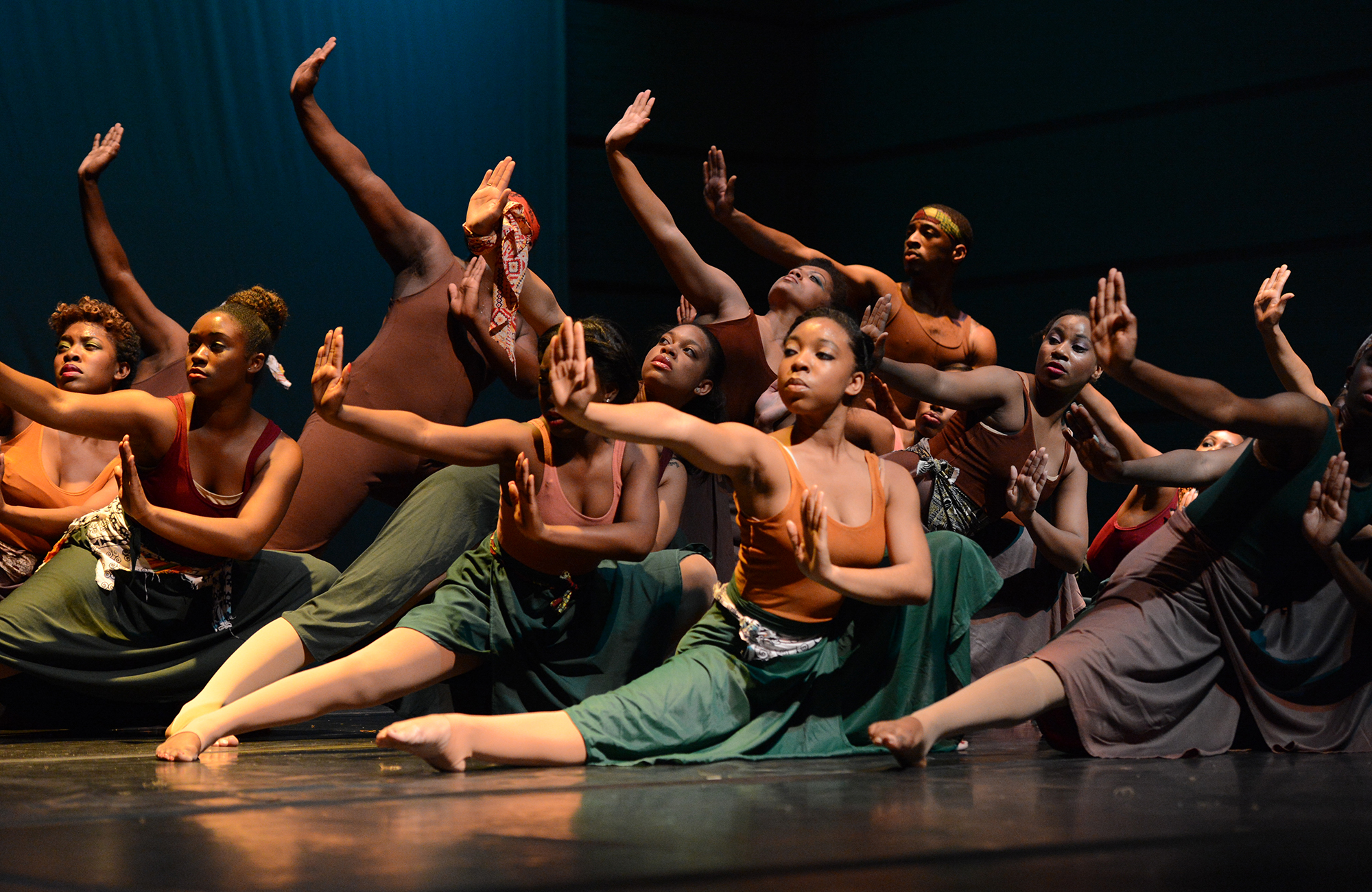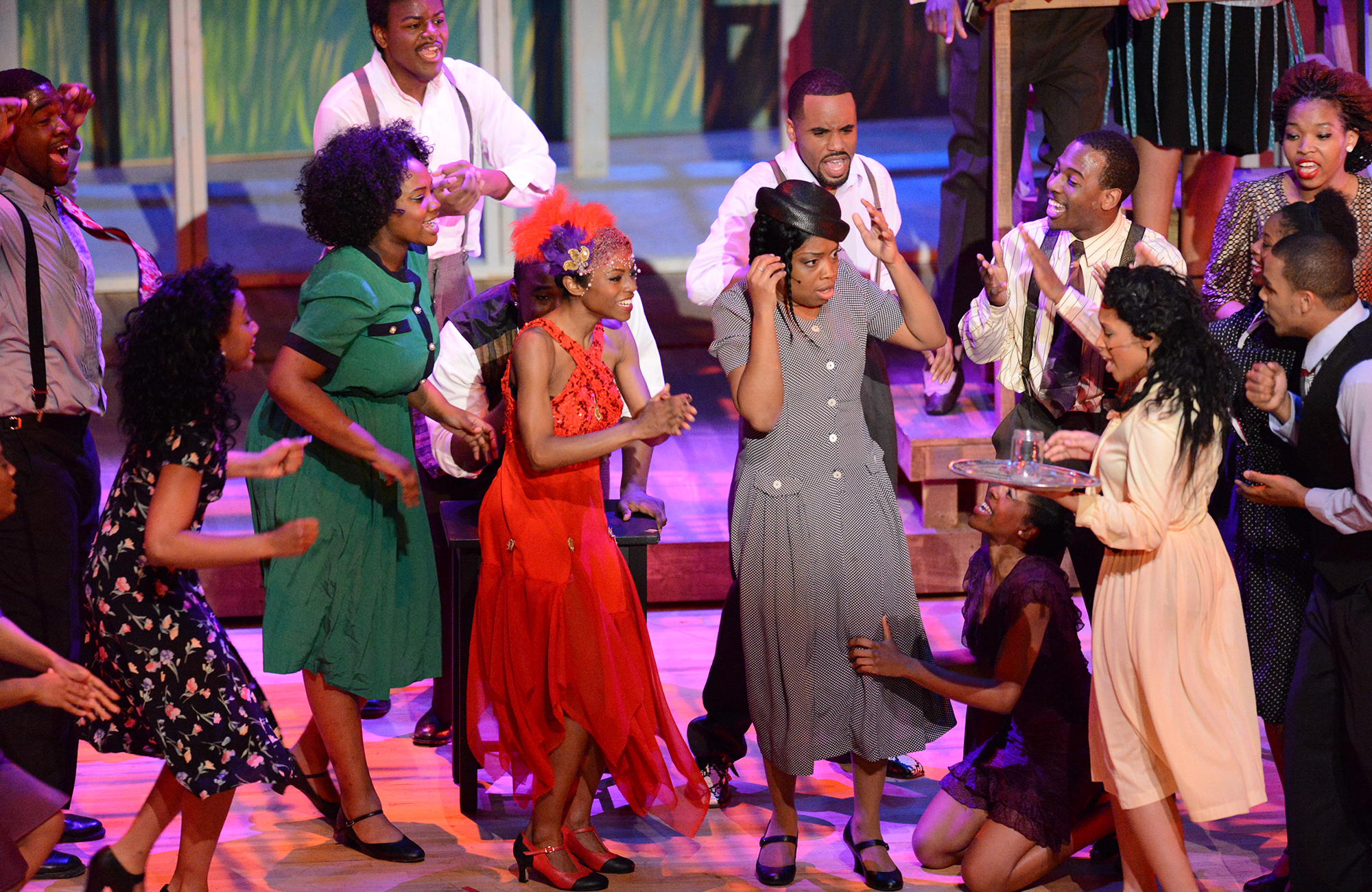Having access to the newest technology and equipment, singing in rooms that were designed to have amazing acoustics, working with professors who were now more empowered because they had a new state-of-the-art classroom made me a better student.
— Kevin S. McAllister, ’04, Artistic Director and Cofounder, ArtsCentric, Inc.
Morgan State University’s architectural gem at 2201 Argonne Drive was many years in the making. The long timeline began in the early 1990s, when Morgan Director of Bands Melvin Miles Jr., ’73 and ’78; Gabriel Tenabe, director of the University’s James E. Lewis Museum of Art (JELMA); Morgan Choir Director Nathan Carter, D.M.A.; Clinton Johnson, ’70, technical director and coordinator of Morgan’s Theatre Arts program; and Morgan President Earl Richardson, Ed.D., were tasked with serving on the planning and design committee for the University’s new fine arts facility.
The group was more than ready for the changes the new building would bring. Together, Tenabe and Miles had nearly four decades of experience working at Morgan by then, and Tenabe and his team had spent much of that time dodging ceiling leaks and wrestling with problems with accessibility to exhibit areas and the loading dock of the Gallery of Art, which was later renamed JELMA. Miles, Johnson and Dr. Carter had coped with inadequate space for their students to practice and rehearse, and the choir had grown accustomed to making the four-mile trip downtown from Morgan’s campus to the Meyerhoff Symphony Hall to perform. The attractive building where all those programs were housed, the original Carl J. Murphy Auditorium and Fine Arts Center, had its official opening in May 1960, on the current site of Morgan’s Richardson Library, and was badly in need of a refresh.
Finally, in 1992, approval came from State of Maryland officials for design and construction of a new fine arts facility, on the parking lot of the former Montebello State Hospital, a property Morgan had recently acquired. The breakthrough followed an astute awareness campaign by Richardson, Tenabe recalls with a smile. The president had invited powerful State legislators to tour the original Murphy building soon after the choir returned from a triumphant series of performances in Finland. Seeing the choir’s tiny practice rooms, Tenabe says, the lawmakers felt compelled to act.
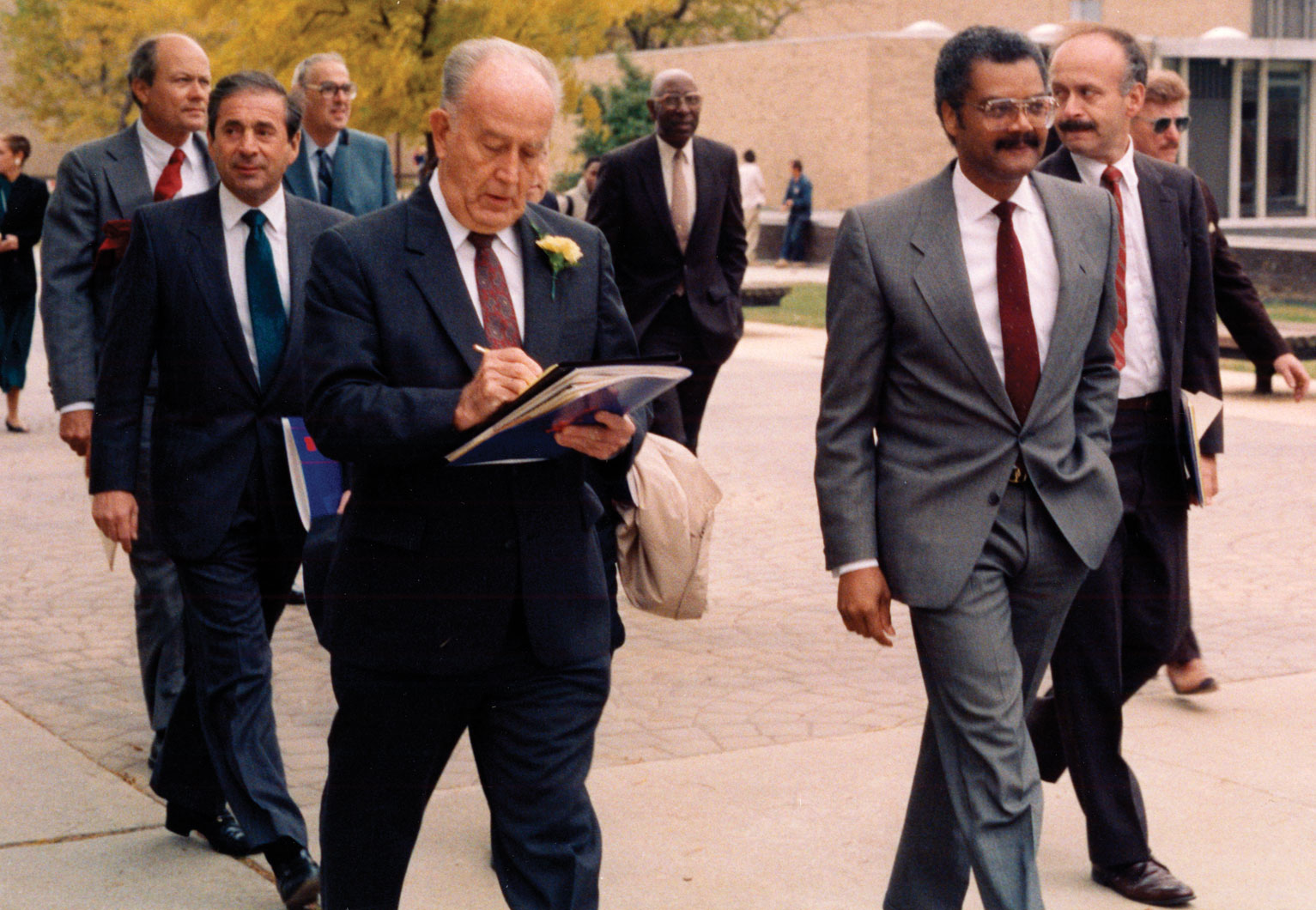
Creative Control
The new Carl J. Murphy Fine Arts Center became Morgan’s first building project in which the University was allowed by the State to make major decisions about design and construction, says Miles. Still, transforming the Morgan committee members’ ideas from concept to reality wasn’t easy, he adds. For example, a long struggle ensued when President Richardson asked the State to increase the number of seats in the new facility’s main performance space from 1,200 to 2,000, he recalls. In the end, the State agreed to the larger number, with the condition that Morgan would pay for the additional seats.
It was not a coincidence that those funds became available, recalls Morgan Regent Linda J. Gilliam, D.M.D. Dr. Gilliam’s husband, Morgan graduate James H. Gilliam Jr., of Morgan’s Class of 1967, had long desired to give back to MSU, and the couple decided in 1990 to make a gift of $1 million to the University. Regent Gilliam admits that amount gave her pause when her husband first suggested it, but after meeting with Richardson and MSU’s head of Development, Cheryl Hitchcock, over lunch and the president’s homemade coconut pie, the Gilliams agreed to increase the gift to $1.5 million.
“So we went from $1 million to $1.5 million over a piece of coconut pie. I’ve always said that was the most expensive pie,” Regent Gilliam says with a laugh. “We both (had) a love of art, particularly music…and the (new) Murphy building was being constructed at that point. So it was Dr. Richardson’s suggestion that we consider the concert hall. And as a tribute, we named it after Jim’s parents,” the James H. and Louise Hayley Gilliam Concert Hall.
Although humorous in retrospect, equipping the building for internet service was another major challenge, Miles says. The Morgan committee’s request to have the building outfitted for Wi-Fi was flatly rejected, he says, and “I can’t tell you the fight we had just to get the State to approve hardwiring the place for internet. It was just an interesting time to be sitting at the table and talking about having a smart building, and having everybody kind of looking at you like you’re trying to build a rocket ship,” he adds with a laugh. “But that was 25, almost 30 years ago.”
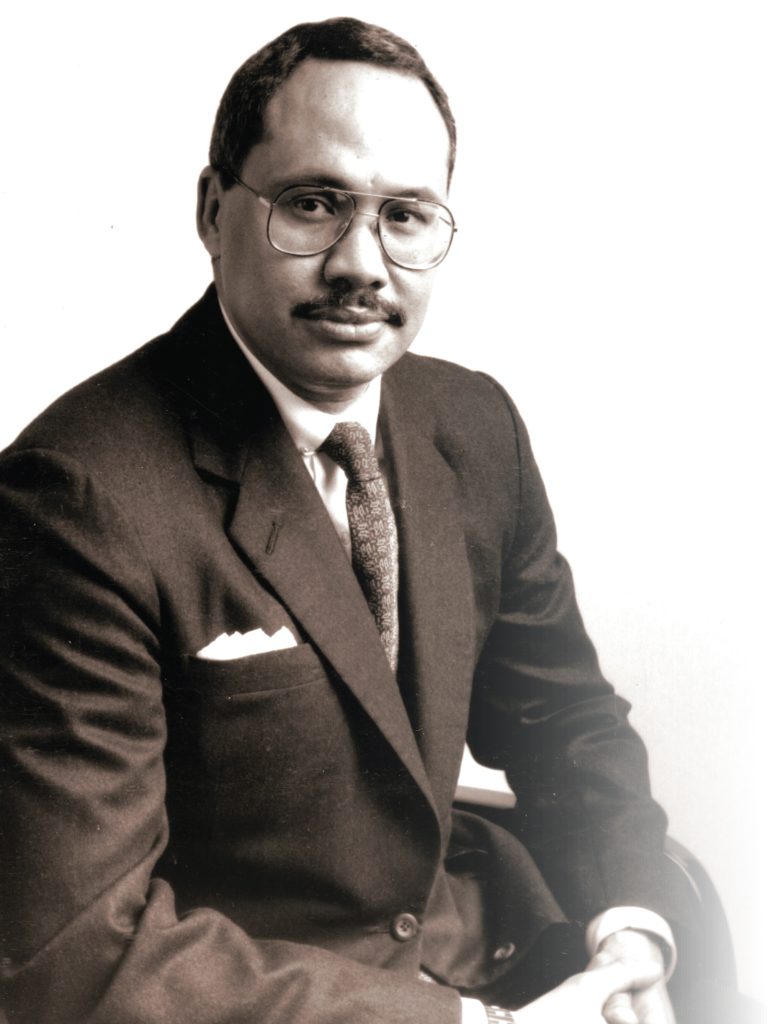
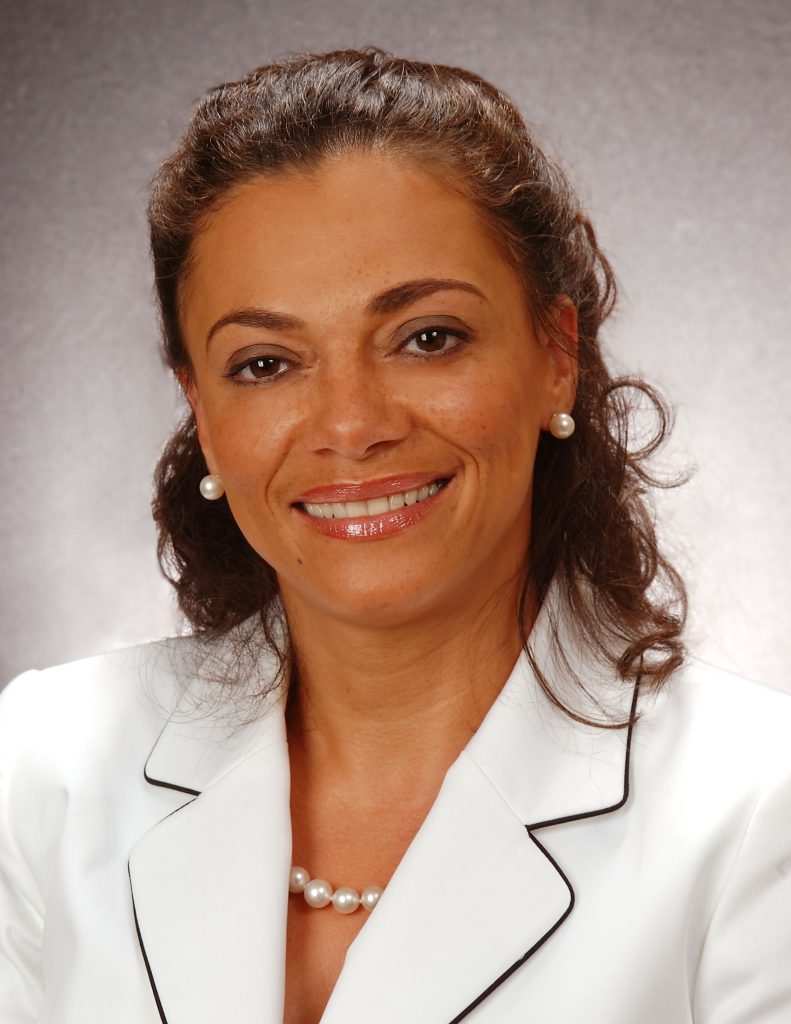
House of Magic
Nine years after planning began, construction of Morgan’s new Carl J. Murphy Fine Arts Center was completed, and by nearly all accounts, the finished product was outstanding. The 140,500-square-foot, four-level building has eight classrooms, five art studios and labs, about a dozen practice rooms and four unique performance venues: a 167-seat Recital Hall; the 271-seat Turpin-Lamb Theatre, named in honor of two renowned former Morgan educators, English professor Waters E. Turpin and theatre arts professor Arthur C. Lamb; an Outdoor Amphitheatre at the rear of the building with stadium seating for 200; and Gilliam Concert Hall, site of the center’s largest stage and seating for an audience as large as 2,036. The building also houses the James E. Lewis Museum of Art, with its collection of sculptures, photography, paintings, collages, drawings, mixed media pieces and more, created by African American, Asian, European and Oceanic artists.
Monica McKinney Lupton, D.M., became the new center’s director, her third employment with Morgan: she had served the University as a development officer in the early 1990s and returned in 2000 on a contractual basis to assist Choir Director Nathan Carter with the preparations for the center’s grand opening event, a performance by world-renowned operatic soprano Jessye Norman on Dec. 1, 2001. After that resounding success, President Richardson asked Dr. McKinney Lupton to come on board full time to lead the center.
“There wasn’t a job description per se in terms of what was expected of me coming into the position, except to make sure that we had a lot of traffic in the building,” McKinney Lupton recalls. “There was an idea at the time that we should rival, because we did in every other respect, the downtown venues like the Meyerhoff and the Lyric…. And that was as important as making sure the facility was used by our students, giving them a professional environment in which to work.”
As center director, McKinney Lupton, who retired from Morgan in January 2021, says she never had the luxury of watching a full performance in Gilliam Concert Hall from the audience view, but she had a long list of memorable experiences in the venue, nonetheless. There was Ray Charles’ “absolutely magical” concert in May 2002; “any number of the R&B shows, oldies, as they were”; Chris Brown at age 17 or 18, who “lifted the roof off the building that night, with girls screaming”; Maxwell, who later did the same with a more adult group of women; many iterations of the Ebony Fashion Fair; Kevin Hart, invited to perform by Morgan’s student government; Tyler Perry’s Madea plays.
“There are just so, so many activities. I don’t have a favorite,” she says.
“I was extremely fortunate to have a staff who enjoyed working at Murphy as much as I did,” McKinney Lupton says. “…They did their absolute best to make each event that occurred in Murphy competitive with any other professional house in Baltimore.”
Behind the Curtain
Dwight Cook has been one of those staff stalwarts. McKinney Lupton worked with him during his time in New York as a Broadway stage manager and a director, then hired him to stage-manage Murphy Fine Arts Center’s grand opening concert and brought him on board full time as production manager for the center in July 2002. Cook’s job is to facilitate the use of technology in the center, especially in its three performance venues. He’s slated to retire this year, with a wealth of good memories centered on “the different entities we have supported and facilitated. We’ve had a plethora of genres and people come here,” Cook says, before recalling a few: countless convocations, lectures, MSU Choir and band concerts and other events for the University; Democratic and Republican candidate forums for the 2008 U.S. presidential election; the Maryland gubernatorial debates in 2002; Dance Theatre of Harlem; the Maryland Music Educators Association All State auditions and adjudications.
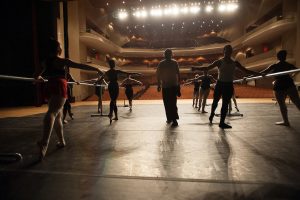 Michelle Obama’s appearance at Murphy Fine Arts Center in 2012 is the clear favorite of Dale Alston, another longtime staffer. A civil engineering graduate of Carnegie Mellon University, Alston, who has served as interim director since McKinney Lupton’s departure, first aspired to be a graphic artist. Bringing her marketing skills to Murphy Fine Arts Center in 2003 after a 20-year career in high-tech stoked her longtime passion for the arts.
Michelle Obama’s appearance at Murphy Fine Arts Center in 2012 is the clear favorite of Dale Alston, another longtime staffer. A civil engineering graduate of Carnegie Mellon University, Alston, who has served as interim director since McKinney Lupton’s departure, first aspired to be a graphic artist. Bringing her marketing skills to Murphy Fine Arts Center in 2003 after a 20-year career in high-tech stoked her longtime passion for the arts.
“When I (began) working for Murphy, I got to see exactly how much I loved being in the environment of creativity and the energy,” says Alston. “And the output was (things) I love,” she adds, “theatre, music, dance and visual arts. I love working behind the curtain…. I love being part of what (brings these things) into being.”
Witnessing the growth of artists up close is another joy of her work, Alston says. “Some of the luminaries (who) have walked these halls, meaning students who have cultivated their art here: it’s impressive, everything from visual arts to our Morgan stars at the Metropolitan Opera.”

‘Mind-Blowing Artistry’
The Murphy Fine Arts Center has been a second home to thousands of budding vocalists, instrumentalists, theatre artists, visual artists and dancers since the highly regarded facility’s opening in 2001. The roster of those Morgan scholars who have gone on to outstanding achievement in their fields is far-reaching and includes artists such as Philadelphia native Issachah Savage, ’03, who has a long list of international operatic credits and is one of many Morgan-trained vocalists who have afforded their skills and talents to the Metropolitan Opera; visual artist Annika Romeyn, ’09, of Canberra, Australia, whose work combining watercolor, drawing and printmaking has won awards and has been exhibited at galleries across her home country; and theatrical director and actor Kevin S. McAllister, ’04, from Detroit.
McAllister graduated from Morgan with a B.A. in Music and had been honing his skills as a stage actor for nearly a decade when he cofounded his own theatre company, Baltimore-based ArtsCentric, Inc., which he still serves as artistic director, helping lead the organization in its mission to create more performance opportunities for African American artists. His many personal acting credits include roles in “Caroline, or Change,” and “Come From Away,” on Broadway.
McAllister spent much of his first year as a student at Morgan in the “old” Murphy Fine Arts building, before the new facility was completed.
“I was affected in every way possible” by the move, McAllister says. “Having access to the newest technology and equipment, singing in rooms that were designed to have amazing acoustics, working with professors who were now more empowered because they had a new state-of-the-art classroom made me a better student.
“I learned from some of the most amazing artists in the world in both the ‘old’ and ‘new’ Murphy,” he adds. “The only difference between the two buildings was the pride we all felt entering the ‘new’ Murphy, because we all knew how much hard work and mind-blowing artistry it took from so many artists to get the ‘new’ Murphy built.”

Inspiring Excellence
The “new” Murphy Fine Arts Center reached a major milestone, its 20th anniversary in fall 2021, in a state of hiatus, undergoing extensive renovations to Gilliam Concert Hall and the Recital Hall that kept the building closed to the public during much of the COVID pandemic. The audience at the reopening event, the 2022 iteration of the MSU Choir’s Christmas Concert, celebrated the return to Murphy last Dec. 11, in a venue with upgraded controls, ventilation and mechanical equipment; new acoustic wood ceiling and wall panels; new carpeting; freshly painted walls; and refinished wood stages.
Despite their high aesthetic standards, longtime occupants of Murphy Fine Arts Center still give the facility kudos, as a working space and as a performance venue, nearly 22 years after its opening.
“…Far, far better than what we had previously,” says Tenabe, whose title is now director of the Office of Museums for MSU.
“This building rivals anyplace that you go, particularly at an HBCU. People come here and marvel at it,” says Miles. “I think the fact that we have it has been an inspiration to further development on campus, in terms of what something excellent should look like and feel like.”
The Rev. Dr. Frances Murphy (“Toni”) Draper, CEO and president of Afro-American Newspapers, former Morgan regent, and granddaughter of the building’s namesake, thinks her grandfather would have been pleased. Carl J. Murphy was a groundbreaking civil rights activist who paved the way for future generations of Black journalists like Draper, during his long, impactful tenure as publisher of the Afro.
“It’s a testament to his many years as the first African American chair of what was then (Morgan’s) Board of Trustees, now the Board of Regents, and to his love for the arts,” Draper says. “The previous fine arts center was named for him, so to have that name come over to the new one was certainly an honor (for our family). It made us feel that his legacy was valued…. It was a beautiful testament to all of the artistic talent Morgan has admitted and developed.”
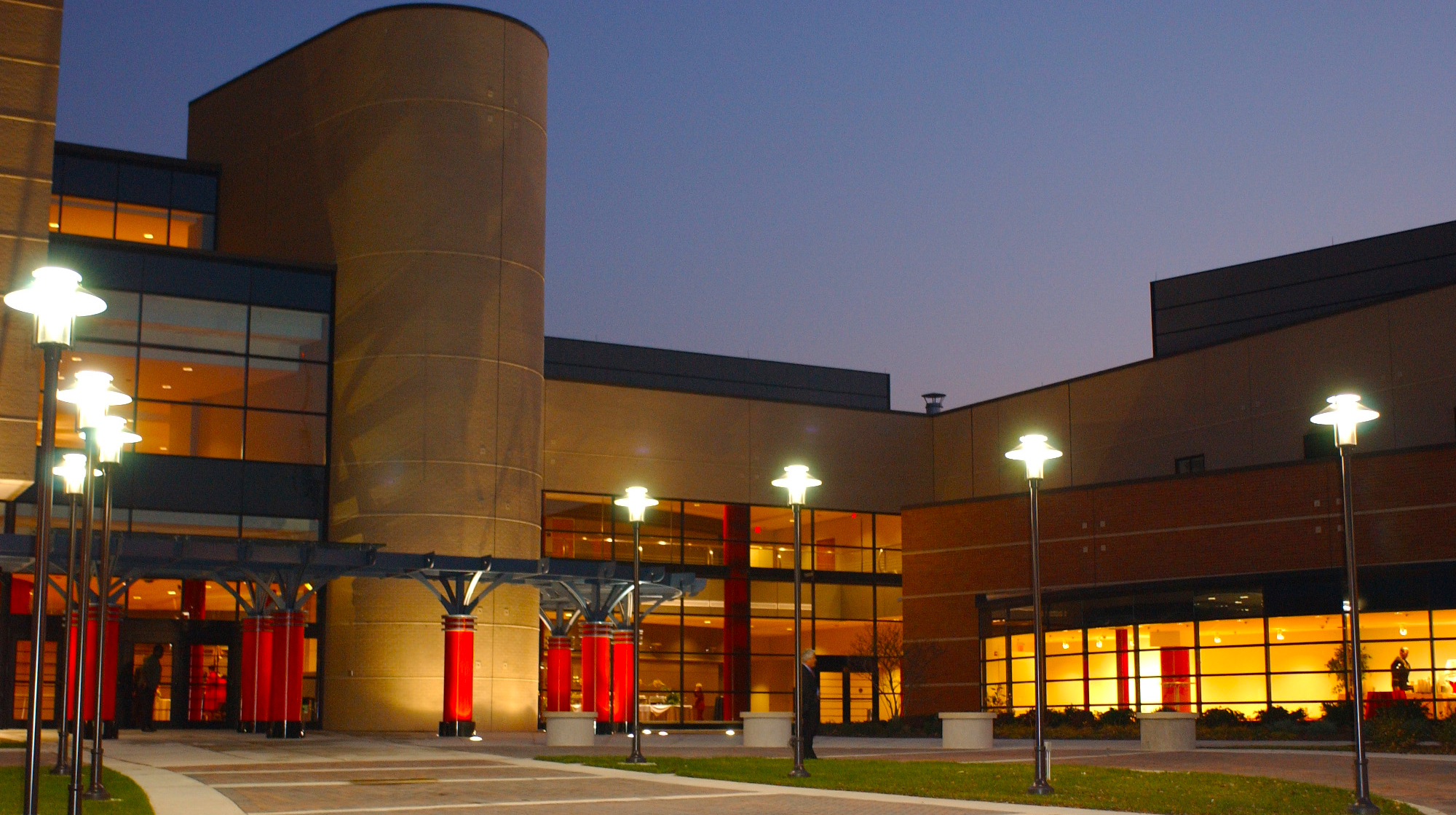
What Lies Ahead
As Morgan State University’s Murphy Fine Arts Center approaches its 25th anniversary, University administrators are looking to continue the Center’s prominence as a destination for arts and culture and for nurturing the next generation of college performers. The quarter-century mark signals a prime opportunity for the Murphy Fine Arts Center to fully embrace its evolution, adopting and adapting to the latest in arts technology, innovative design and ever-evolving performing arts landscape.
“The University has received much well-deserved praise in recent years for the planning, design and construction of our newest facilities, from CBEIS to the Morgan Business Center to Jenkins Hall Behavioral and Social Sciences Center to Tyler Hall,” says Morgan President David K. Wilson. “The blueprint of that success was realized under the previous administration’s vision to deliver a world-class fine arts edifice to serve our students and attract diverse arts devotees from throughout the region to our historic campus. As we look to Murphy Fine Arts Center’s future, we will exercise our due diligence and devise a work group to explore what denotes a modern 21st-century arts education and performance center.”
Recognizing the importance of adapting to modern trends in the performing arts space, a future Murphy Fine Arts Center would centerpiece emerging programs in digital arts, further integrating technology into its classrooms and studios and empowering students to delve into new frontiers of artistic expression. Virtual reality and augmented reality installations that enable artists to create immersive experiences that transcend traditional boundaries represent a likely trajectory for a renewed Center. Additions in this capacity will provide more space for art studios and labs, equipped with the latest digital tools to enhance the creative environment for aspiring artists across various disciplines and will foster dynamic, collaborative learning atmospheres for students.
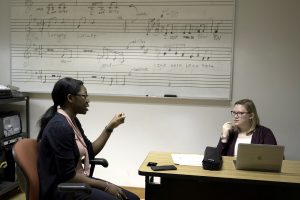 Beyond the physical enhancements, the Murphy Fine Arts Center’s future lies in fostering collaboration between diverse artistic disciplines. Cross-disciplinary programs and events that allow instrumentalists, vocalists, visual artists, actors and dancers to collaborate on groundbreaking projects that challenge artistic boundaries will be an area of great opportunity.
Beyond the physical enhancements, the Murphy Fine Arts Center’s future lies in fostering collaboration between diverse artistic disciplines. Cross-disciplinary programs and events that allow instrumentalists, vocalists, visual artists, actors and dancers to collaborate on groundbreaking projects that challenge artistic boundaries will be an area of great opportunity.
Marrying tradition and innovation will be central to any proposed future upgrades or modifications to the Murphy Fine Arts Center. Across Morgan’s sprawling urban campus, Morgan Vice President for Facilities, Design and Construction Kim McCalla and her team have been very intentional about preserving Morgan’s natural charm and storied history while integrating modern amenities and state-of-the-art facilities. Envisioning what the future holds for Morgan’s performing arts center will be no different.
According to McCalla, there are a number of short-term plans on the docket for Murphy Fine Arts: “I know we have some renovations and structural things that we need to do to the building now. We’ll change the flooring out and change the furniture out and give it a whole upgrade physically with that…give it a refresh.”
As for long-term plans and the potential for expansion, “it really depends on what the public wants, what the University wants, what the University needs. I think as a part of our master plan that’s going to come up,” adds McCalla.
“As we do with all our buildings, we select the architect that is best suited for the project. So, with our science building, we look for architects who have science-related experiences. It would be the same thing for Murphy. We would look for an architect that is experienced in the performing (and visual) arts: art, music, all of it, not just one genre or another,” she continues.
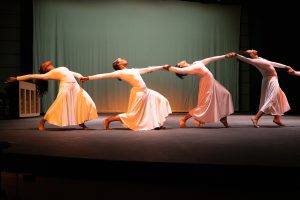 Any future enhancements made to Murphy will be executed in a reaffirming fashion that reinforces its position as a premier venue, attracting top-tier performers from around the world and solidifying Morgan State University as a cultural epicenter.
Any future enhancements made to Murphy will be executed in a reaffirming fashion that reinforces its position as a premier venue, attracting top-tier performers from around the world and solidifying Morgan State University as a cultural epicenter.
“Murphy Fine Arts Center served a very valuable purpose, filling a noticeable void in the Black arts community here in Baltimore when we opened more than two decades ago,” reflects Wilson. “Morgan takes great pride in being a standard bearer for the advancement of arts and culture through this remarkable center and will ensure its greatest potential is realized for performing arts students and art patrons today and in the generations that follow.”
The next 25 years of the Murphy Fine Arts Center will be a testament to Morgan’s dedication to artistic excellence and innovation. With expanded facilities, incorporation of digital arts, modernized performance venues and emphasis on collaboration and inclusivity, the center will stand as a beacon of inspiration and opportunity for tomorrow’s artists, continuing to shape the future of arts and culture in Baltimore, and the region, for years to come.

